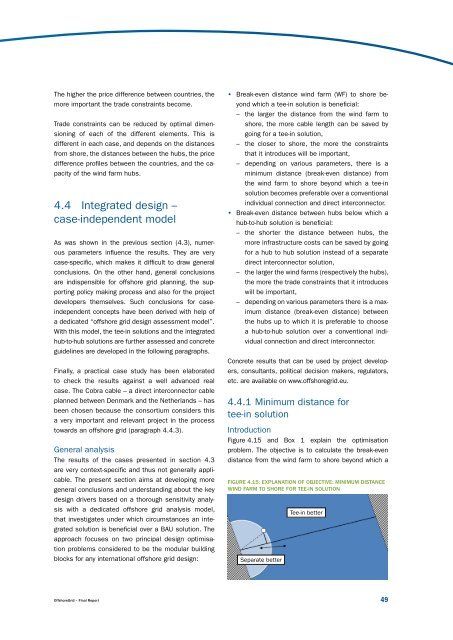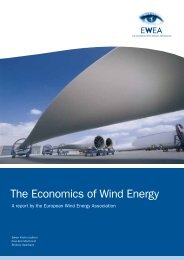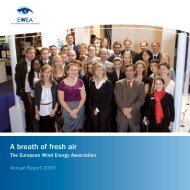Offshore Electricity Infrastructure in Europe - European Wind Energy ...
Offshore Electricity Infrastructure in Europe - European Wind Energy ...
Offshore Electricity Infrastructure in Europe - European Wind Energy ...
You also want an ePaper? Increase the reach of your titles
YUMPU automatically turns print PDFs into web optimized ePapers that Google loves.
The higher the price difference between countries, the<br />
more important the trade constra<strong>in</strong>ts become.<br />
Trade constra<strong>in</strong>ts can be reduced by optimal dimension<strong>in</strong>g<br />
of each of the different elements. This is<br />
different <strong>in</strong> each case, and depends on the distances<br />
from shore, the distances between the hubs, the price<br />
difference profiles between the countries, and the capacity<br />
of the w<strong>in</strong>d farm hubs.<br />
4.4 Integrated design –<br />
case-<strong>in</strong>dependent model<br />
As was shown <strong>in</strong> the previous section (4.3), numerous<br />
parameters <strong>in</strong>fluence the results. They are very<br />
case-specific, which makes it difficult to draw general<br />
conclusions. On the other hand, general conclusions<br />
are <strong>in</strong>dispensible for offshore grid plann<strong>in</strong>g, the support<strong>in</strong>g<br />
policy mak<strong>in</strong>g process and also for the project<br />
developers themselves. Such conclusions for case<strong>in</strong>dependent<br />
concepts have been derived with help of<br />
a dedicated “offshore grid design assessment model”.<br />
With this model, the tee-<strong>in</strong> solutions and the <strong>in</strong>tegrated<br />
hub-to-hub solutions are further assessed and concrete<br />
guidel<strong>in</strong>es are developed <strong>in</strong> the follow<strong>in</strong>g paragraphs.<br />
F<strong>in</strong>ally, a practical case study has been elaborated<br />
to check the results aga<strong>in</strong>st a well advanced real<br />
case. The Cobra cable – a direct <strong>in</strong>terconnector cable<br />
planned between Denmark and the Netherlands – has<br />
been chosen because the consortium considers this<br />
a very important and relevant project <strong>in</strong> the process<br />
towards an offshore grid (paragraph 4.4.3).<br />
General analysis<br />
The results of the cases presented <strong>in</strong> section 4.3<br />
are very context-specific and thus not generally applicable.<br />
The present section aims at develop<strong>in</strong>g more<br />
general conclusions and understand<strong>in</strong>g about the key<br />
design drivers based on a thorough sensitivity analysis<br />
with a dedicated offshore grid analysis model,<br />
that <strong>in</strong>vestigates under which circumstances an <strong>in</strong>tegrated<br />
solution is beneficial over a BAU solution. The<br />
approach focuses on two pr<strong>in</strong>cipal design optimisation<br />
problems considered to be the modular build<strong>in</strong>g<br />
blocks for any <strong>in</strong>ternational offshore grid design:<br />
<strong>Offshore</strong>Grid – F<strong>in</strong>al Report<br />
• Break-even distance w<strong>in</strong>d farm (WF) to shore beyond<br />
which a tee-<strong>in</strong> solution is beneficial:<br />
– the larger the distance from the w<strong>in</strong>d farm to<br />
shore, the more cable length can be saved by<br />
go<strong>in</strong>g for a tee-<strong>in</strong> solution,<br />
– the closer to shore, the more the constra<strong>in</strong>ts<br />
that it <strong>in</strong>troduces will be important,<br />
– depend<strong>in</strong>g on various parameters, there is a<br />
m<strong>in</strong>imum distance (break-even distance) from<br />
the w<strong>in</strong>d farm to shore beyond which a tee-<strong>in</strong><br />
solution becomes preferable over a conventional<br />
<strong>in</strong>dividual connection and direct <strong>in</strong>terconnector.<br />
• Break-even distance between hubs below which a<br />
hub-to-hub solution is beneficial:<br />
– the shorter the distance between hubs, the<br />
more <strong>in</strong>frastructure costs can be saved by go<strong>in</strong>g<br />
for a hub to hub solution <strong>in</strong>stead of a separate<br />
direct <strong>in</strong>terconnector solution,<br />
– the larger the w<strong>in</strong>d farms (respectively the hubs),<br />
the more the trade constra<strong>in</strong>ts that it <strong>in</strong>troduces<br />
will be important,<br />
– depend<strong>in</strong>g on various parameters there is a maximum<br />
distance (break-even distance) between<br />
the hubs up to which it is preferable to choose<br />
a hub-to-hub solution over a conventional <strong>in</strong>dividual<br />
connection and direct <strong>in</strong>terconnector.<br />
Concrete results that can be used by project developers,<br />
consultants, political decision makers, regulators,<br />
etc. are available on www.offshoregrid.eu.<br />
4.4.1 M<strong>in</strong>imum distance for<br />
tee-<strong>in</strong> solution<br />
Introduction<br />
Figure 4.15 and Box 1 expla<strong>in</strong> the optimisation<br />
problem. The objective is to calculate the break-even<br />
distance from the w<strong>in</strong>d farm to shore beyond which a<br />
FIGURE 4.15: EXPlANATION OF ObjEcTIvE: MINIMUM dISTANcE<br />
WINd FARM TO ShORE FOR TEE-IN SOlUTION<br />
Separate better<br />
Tee-<strong>in</strong> better<br />
49









